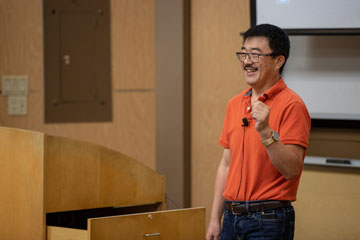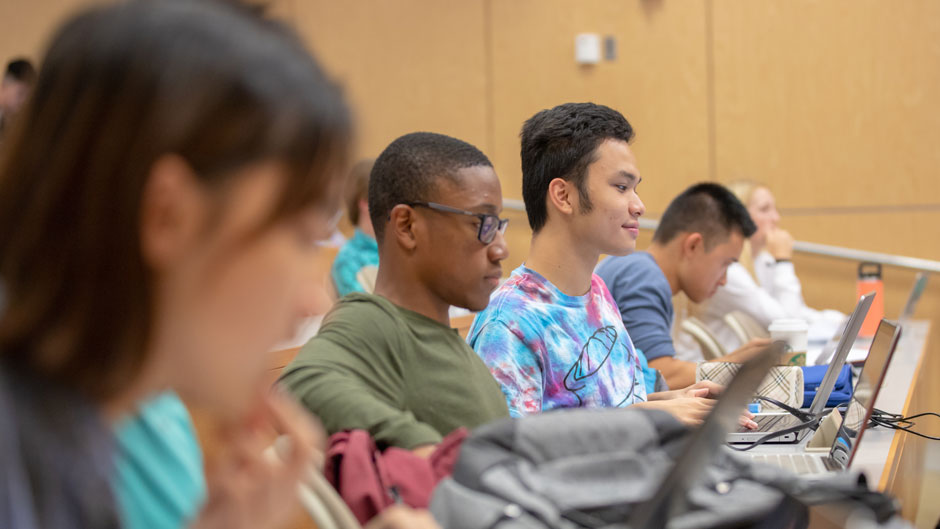Seth Crail is a senior instrumental performance major hoping to compose music for video games. He spends hours fine-tuning his saxophone skills in jazz at the Frost School of Music. But last fall, he also spent lots of time learning the computer programming language Java, and writing code.
Although it may seem like a contrast of interests, Crail is no longer the exception at the University of Miami. Many students from a variety of majors, like Crail, are taking an introductory programming class to expose themselves to the field.
“We live in a technologically present era, and it’s natural that technology will be a part of any career path, so it’s natural for us to be interested in programming as a younger generation,” he said. “I haven’t really used the programming yet, but I find that knowing more things is always helpful and enriches me as a person.”
At UM, the interest in computer programming is expanding far beyond Computer Science majors. The majority of those who take the Introduction to Programming course in the Department of Computer Science are no longer Computer Science students, but those who want to go into the sciences, or students aiming to work in the business world. In the past academic year alone, 78 percent of students taking Introduction to Programming were not computer science majors. This is a trend that the department has noticed for at least the past five years, said its chair, Professor Geoff Sutcliffe.
“The number of people realizing that computing gives you opportunities is becoming evident and we are adapting to this growing population,” Sutcliffe added. “In the current Introduction to Programming class, more than half of the students are from outside our department, but they all want to learn how to program.”
Despite the growing interest from outside the department, Sutcliffe said there are also more students interested in computer science. Since he started working at UM in 2001, the number of majors has grown from 30 to nearly 200, Sutcliffe added, causing the number of faculty to double as well.
“Fifteen years ago, parents would say ‘please go into a pre-law or pre-med track,’ but now parents are saying ‘go into computer science,’ whereas they might not have done that before,” Sutcliffe said. “Therefore, in the last few years, the nature of our program has changed.”

Professor Mitsunori Ogihara, who teaches Introduction to Programming, a primer on the programming language Java, said he has noticed a steady increase in his class sizes. While five years ago his class used to have about 100 students, this fall, there are 146 students packed into a large lecture room, most of whom are not Computer Science majors.
Parker Hughes, a sophomore finance major, is taking Ogihara’s class this fall. A native of Houston, Hughes said he saw the value of learning programming from speaking with his father, a successful businessman who often laments his lack of technological familiarity. Meanwhile, Hughes’ stepmother, who is also a thriving businesswoman, majored in computer science.
“My thought was I’m growing up in a society that’s fully based on technology,” Hughes said. “So if I can understand the way that technology works, I’ll have a much better grasp of a way that a business should act in regards to technology.”
Hughes said he is struggling a bit with learning an entirely new computer language, and often asks his friend—a computer science major—for help with assignments. Yet, he likes the challenge and Hughes has decided to add a computer science minor.
Since technology is so prevalent today, Ogihara said he has noticed that his current students are more capable when it comes to completing basic computer functions. Yet, due to his more diverse classes, Ogihara is not always able to teach with the level of rigor that he could in the past.
“Ideally, there should be a different track for computer science majors and non-computer science majors, but right now we don’t have the capacity for it,” Ogihara said.
In response to the demand for more programming knowledge, Sutcliffe said his department has started offering a class in a simple programming language called Python, which is often easier for novice programmers to learn. The class is now filled with many graduate science students who want to learn programming to help with their research projects.
“We changed the tone of the class based on the enrollment,” Sutcliffe said, adding that Computer Science faculty are now working on another version of the Python class for students from the arts and humanities.

